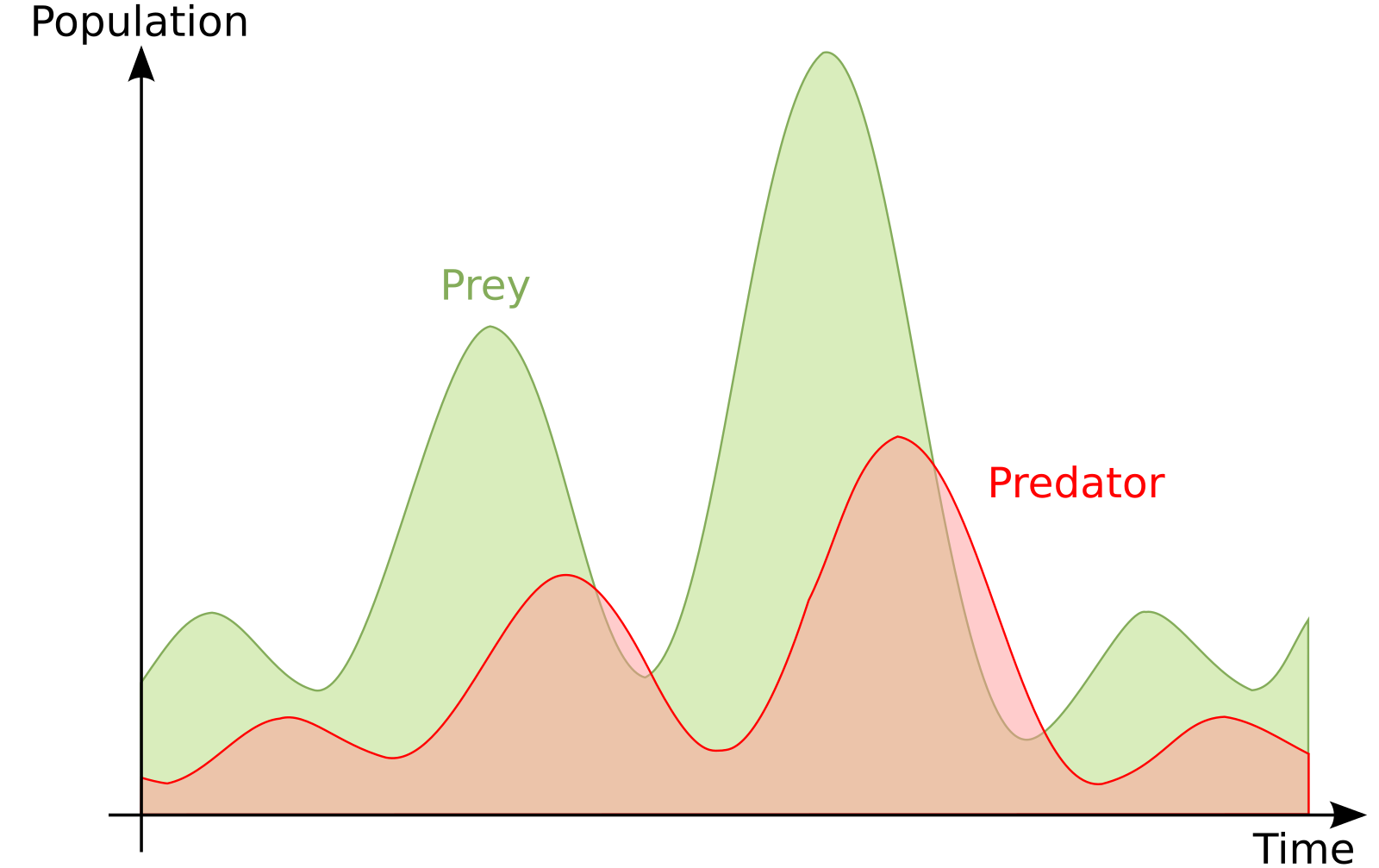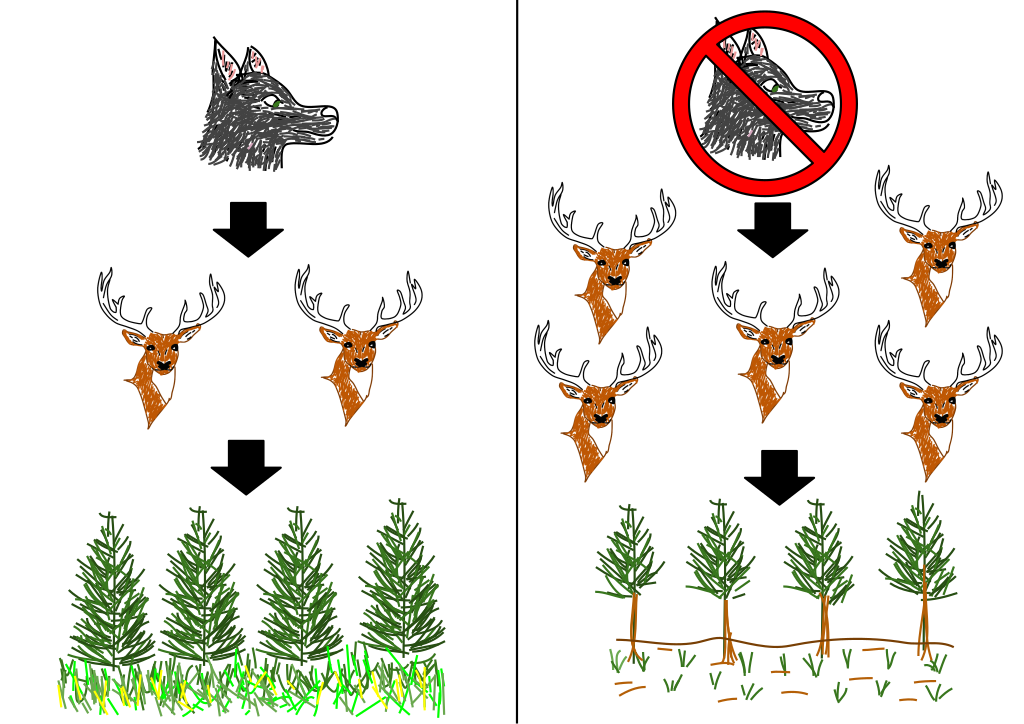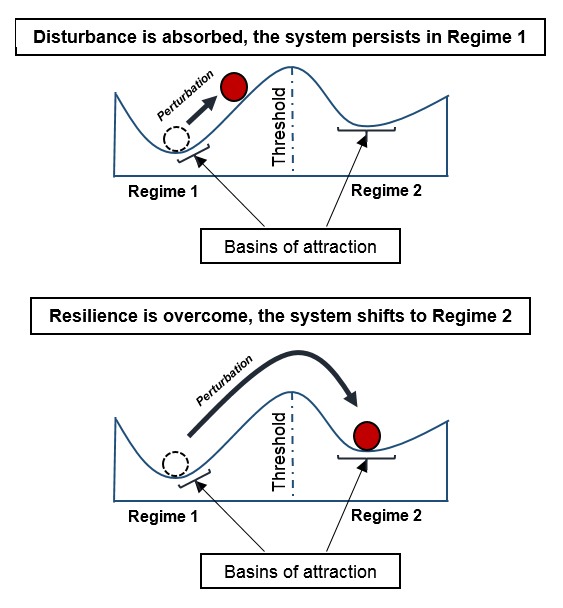IB Syllabus focus:
‘Interactions produce emergent properties absent in parts (e.g., predator–prey cycles, trophic cascades). Resilience is capacity to resist, recover, or adapt. Diversity and storage size enhance resilience; human actions (e.g., deforestation) reduce both.’
Understanding emergent properties and resilience is central to the study of systems in environmental science. These concepts explain how interactions create new outcomes and influence ecosystem stability.
Emergent Properties
What Are Emergent Properties?
Emergent properties occur when the combined behaviour of system components produces outcomes not visible when observing individual parts in isolation.
Emergent Properties: Characteristics of a system that arise from the interaction of its components, which cannot be predicted by examining each component separately.
For example, predator–prey cycles or trophic cascades represent system-level behaviours that cannot be understood solely from looking at one species.
Examples of Emergent Properties
Predator–prey cycles: Fluctuations in predator and prey populations over time arise from mutual interactions, rather than individual species behaviour alone.

Time-series plot showing oscillations of prey (blue) and predator (red) abundances with a characteristic time lag, illustrating emergent cycles from species interactions. Axes and series are clearly labelled to emphasise the system-level pattern rather than individual behaviour. Source.
Trophic cascades: When predators regulate herbivores, which in turn affects vegetation, the system displays properties beyond single-species dynamics.

Diagram contrasting an intact food web (with apex predators) versus a system where the predator is removed, leading to herbivore release and vegetation decline—an emergent, system-level effect. Note: the right panel includes mention of carrying capacity, which is additional detail not required by this subsubtopic but consistent with ecological framing. Source.
Nutrient cycling: Interactions among decomposers, producers, and consumers generate a continuous recycling of matter, which is not evident if each organism is studied in isolation.
These examples illustrate that emergent properties often enhance ecosystem organisation and stability, but they can also amplify disturbances.
Key Features of Emergent Properties
They depend on interactions rather than isolated elements.
They may be predictable at the system scale but not at the component level.
They highlight the importance of adopting a systems approach in environmental studies.
Resilience
Definition and Importance
Resilience describes how well a system can withstand or recover from disturbance without shifting to an entirely different state.

Conceptual diagram of a system’s state (ball) within basins of attraction (cups), illustrating how deeper basins represent greater resilience and larger perturbations are needed to cross a threshold into an alternative regime. Labels identify threshold and basins of attraction, directly supporting the terminology in this subsubtopic. Source.
Resilience: The capacity of a system to resist, recover, or adapt to disturbance while maintaining its essential structure and function.
High resilience increases the likelihood that ecosystems continue functioning after environmental stress or human impacts.
Factors Enhancing Resilience
Resilience is not uniform across all systems. It depends on several reinforcing characteristics:
Biodiversity: Greater species richness and functional diversity provide more pathways for recovery.
Large storages: Ecosystems with significant nutrient or energy reserves (e.g., large forests) recover faster.
Complex food webs: Multiple trophic interactions distribute pressures and reduce dependency on single links.
Genetic variation: Species with wider genetic diversity adapt better to new environmental pressures.
Human Impacts on Resilience
Human activity can reduce resilience by disrupting critical processes:
Deforestation diminishes storage of carbon and biodiversity, reducing recovery potential.
Pollution undermines water and soil quality, limiting ecosystem adaptability.
Climate change introduces novel stresses at rates faster than ecosystems can adapt.
Habitat fragmentation weakens population connectivity, reducing recovery after local disturbances.
In each case, human actions can push systems toward thresholds where resilience is diminished, and recovery becomes unlikely.
Relationship Between Emergent Properties and Resilience
Interconnectedness
Emergent properties and resilience are deeply linked:
Emergent behaviours like predator–prey cycles often stabilise ecosystems by regulating populations.
Loss of emergent interactions (such as top predator removal) can reduce resilience, leading to imbalances like herbivore overpopulation.
Resilience itself can be considered emergent, since it arises from the combination of biodiversity, storage capacity, and interactions.
Positive and Negative Outcomes
Positive: Diverse emergent processes buffer ecosystems against shocks, supporting sustainability.
Negative: Disturbance-driven emergent properties (e.g., algal blooms) may reduce resilience and drive regime shifts.
Measuring and Observing Resilience
Indicators of High Resilience
Stable population dynamics despite environmental variability.
Rapid return to equilibrium after disturbance.
Maintenance of biodiversity and ecosystem services across time.
Low-Resilience Indicators
Systems that collapse after shocks (e.g., coral reefs bleaching under climate stress).
Loss of key species leading to cascading failures.
Reduced ability to provide vital services such as clean water or soil fertility.
Behaviour-Time Graphs
While not specified directly in this subsubtopic, behaviour-time graphs can sometimes illustrate resilience by showing how quickly or completely a system returns to its prior state after disturbance.
Applications in Environmental Systems and Societies
Understanding emergent properties and resilience helps in:
Designing conservation strategies that maintain biodiversity and storages.
Predicting ecosystem responses to human pressures such as urbanisation or agriculture.
Supporting sustainable management, as resilient systems better provide long-term ecosystem services.
Policy and Management Implications
Ecosystem-based management incorporates emergent properties to maintain resilience.
Restoration projects aim to rebuild storage size and biodiversity, enhancing recovery.
Protected areas reduce human impacts, preserving interactions that underpin emergent stability.
By recognising emergent properties and resilience as critical features of socio-ecological systems, environmental managers and policymakers can better safeguard ecosystems against future uncertainties.
FAQ
Emergent properties go beyond linear cause-and-effect because they arise from the complex interactions of many components within a system.
For example, predator–prey cycles are not explained by one factor but by the interplay of reproduction rates, predation pressures, and resource availability. This non-linearity means emergent properties often show patterns that cannot be predicted by studying individual species in isolation.
Biodiversity enhances resilience because it provides multiple functional roles within an ecosystem.
If one species declines, others can compensate, ensuring critical processes like pollination, nutrient cycling, and energy transfer continue.
Diverse gene pools also give populations better chances of adapting to new environmental stresses.
High biodiversity therefore creates overlapping safety nets that maintain system stability.
Several human actions diminish resilience by undermining biodiversity and storage capacities:
Overfishing disrupts predator–prey relationships, destabilising marine food webs.
Large-scale monoculture farming reduces genetic and species diversity.
Deforestation eliminates carbon and nutrient stores, weakening recovery potential after disturbance.
Each reduces the system’s ability to recover from shocks, making it more vulnerable to collapse.
Yes, in some cases strong resilience can lock a system into an undesirable state.
For example, heavily degraded grasslands invaded by hardy plant species may resist restoration efforts because the invaders dominate resources. In such cases, resilience maintains an unhealthy equilibrium, requiring significant external intervention to shift the system back to a more sustainable state.
Scientists use system models, long-term monitoring, and controlled experiments to study emergent properties.
Mathematical models (e.g., Lotka–Volterra equations) simulate predator–prey interactions.
Field studies track trophic cascades following predator reintroductions, such as wolves in Yellowstone.
Computer simulations test how biodiversity loss alters resilience across scenarios.
These methods highlight patterns that only emerge when components are studied together rather than separately.
Practice Questions
Question 1 (2 marks)
Define the term resilience in the context of environmental systems.
Mark Scheme:
1 mark for stating that resilience refers to the ability of a system to resist or recover from disturbance.
1 mark for including that resilience allows the system to maintain its essential structure and function.
Question 2 (5 marks)
Using examples, explain how emergent properties contribute to the resilience of ecosystems.
Mark Scheme:
1 mark for identifying that emergent properties arise from interactions between components of a system.
1 mark for explaining that emergent properties, such as predator–prey cycles, regulate population dynamics.
1 mark for linking trophic cascades to ecosystem balance and stability.
1 mark for connecting biodiversity or storage size to enhanced resilience through emergent processes.
1 mark for including at least one example that shows how loss of emergent interactions (e.g., removal of predators) reduces resilience.

